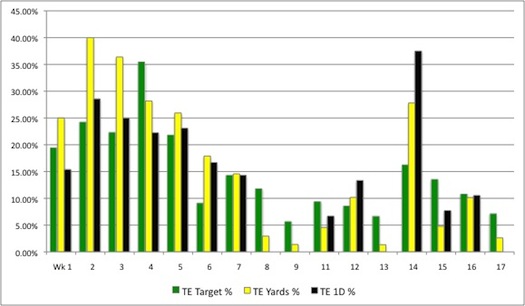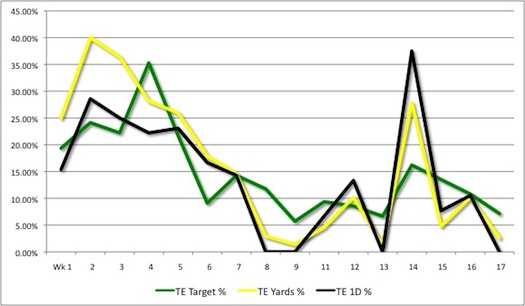
 In each of the past three games, Aaron Rodgers and the Green Bay Packers offense have done something they have only done once since Week 5: thrown a touchdown pass to a tight end. Donald Lee accounts for two of those touchdowns, and we just saw Tom Crabtree score his first NFL touchdown in Sunday’s NFC Wild Card game against the Philadelphia Eagles.
In each of the past three games, Aaron Rodgers and the Green Bay Packers offense have done something they have only done once since Week 5: thrown a touchdown pass to a tight end. Donald Lee accounts for two of those touchdowns, and we just saw Tom Crabtree score his first NFL touchdown in Sunday’s NFC Wild Card game against the Philadelphia Eagles.
All of the touchdown passes came from near the goal line, and both of the scoring tight ends had fewer than 10 total yards of production in each game.
After the final regulation game against the Chicago Bears, frequent commenter “Ron LC” made an interesting note about Mike McCarthy’s use of the tight end this season. He wrote: “Lee’s TD last week has identified an area where MM seems to have given up. The TE as a key player in getting the 1st down and controlling the ball.”
In response to this, I decided to do some research to see if it was an accurate assessment. What I found was interesting, but not totally surprising.
The following chart and graphs present the data I uncovered (click on the chart for full resolution):
KEY
TARG% = TE Targets / Total Pass Attempts
YDS% = TE Yards / Total Pass Yards
TD% = TE Touchdowns / Total Passing Touchdowns
First Down TE% = TE First Downs / Passing First Downs
LOSING FINLEY HURT PRODUCTION . . .
Without even realizing it, I made one big assumption before even starting to collect the data: the injury to Jermichael Finley in Week 5 against the Washington Redskins was responsible for the decrease in production from the tight ends.
And I was right.
If you will notice in the chart, I separated the data into three sections. The first section encompasses the four weeks in which Finley was healthy and active. Though limited in sample size, this gives us a baseline to work with when analyzing the rest of the season.
The second section is only one game – the one in which Finley was injured. I separated this from the others, because I felt it was unique to the situation. Finley practically didn’t play at all in that game, since he was injured early and was never targeted. But Mike McCarthy had still made the game plans with him in mind, which means he still intended to utilize the tight end a significant amount. In fact, rookie Andrew Quarless pretty much replaced Finley in that game, as he accounted for 4 receptions for 76 yards and a touchdown.
The final section represents life in the Green Bay offense without Finley, and as you can see, things got pretty dismal for the tight end position.
In the final eleven games, the tight ends were only targeted on 10.46% of all passing attempts. This is a steep drop off from the 23.77% of passes thrown to the tight ends in the first four games.
The yards produced from those targets is even more striking.
When Finley was in the mix, the tight ends accounted for 33.51% of all passing yardage, compared with a measly 9.03% after his injury.
The only area Finley didn’t seem to make a difference statistically is in touchdowns; however, most Packers fans should know that this is probably just based on the small sample size. Jermichael Finley was a big threat in the end zone, and one could probably say with a high level of confidence that, had he not been injured, he would have made plenty more touchdowns as the season progressed.
After all, Finley did manage five touchdowns in thirteen games last season.
. . . BUT FINLEY WAS AN ANOMALY
A part of the puzzle is still missing, though. It’s all well and good to know what happened during this season, but how does that compare to Mike McCarthy’s offenses from previous seasons?
The answer might shock you a tiny bit.
Below the main chart, you will notice I broke down the tight end production by year, starting with McCarthy’s first year as head coach. In this span, Donald Lee is probably the biggest constant at the position, as the earlier seasons saw the waning years of Bubba Franks, and the later seasons have seen the rise of Jermichael Finley.
What I immediately noticed is how much the 2009 season stuck out in terms of tight end production.
In comparison to the overall passing stats, the number of targets and yards by tight ends in 2009 are about 10% higher than every other season of McCarthy’s tenure. Similarly, only the 2007 season came close in producing as many touchdowns by tight ends as 2009 did.
This just goes to show what we’ve known about Finley all along: he is an anomaly at this position.
It is not just a coincidence that Finley’s rise to a starting role in 2009 created a substantial spike in production by tight ends, especially since Donald Lee didn’t really see much of a drop in his receptions (37) since the 2008 season (39). Finley is a monster of a tight end, and as any good coach will do, McCarthy reworked the offense to take advantage of his biggest weapons.
DOWN ON FIRST DOWNS
The other part of the point made by “Ron LC” is how much the tight end has been used to pick up first downs for the offense.
In four games, Jermichael Finley gained eleven first downs. All of the other tight ends – throughout the entire season – only have a combined total of seventeen. Of those, Andrew Quarless had twelve, Donald Lee had three, and Tom Crabtree had two.
I wasn’t able to go back and get the first down information on previous seasons, but based on all the other information, I would conjecture that we’d see a similar dropoff.
During the last eleven weeks, the most first downs the tight ends made in a game came against the Detroit Lions, when they had three. Interestingly, all three of these first downs were thrown by Matt Flynn after Rodgers had left with a concussion.
Of course, this overall trend might have more to do with Aaron Rodgers’ trust in his tight ends than anything else.
LOOKING BEHIND THE STATS
Statistics are just that: statistics. They are not going to give you the whole story, but they can be a good starting point for finding trends and discussing broad topics. And the data I was able to unearth this week has been useful in confirming what we (haven’t) seen since Jermichael Finley injured his knee.
The tight ends simply have not been utilized that much in the offense.
My biggest question in light of all this information is: what happened to Donald Lee?
You could imagine that Mike McCarthy might not trust his two rookie tight ends in Andrew Quarless and Tom Crabtree when it comes to passing the ball and moving the chains. But when Quarless has made almost twice as many receptions, gained more than three time the number of yards, and made four times the number of first downs as Lee has, then that conclusion falls a little short.
Even the running game can’t explain the drop in production.
Since Ryan Grant went on injured reserve after Week 1, the running game has been a gigantic question mark for Green Bay. And the argument could be made that it’s only now finding it’s rhythm. So it’s hard to believe that Brandon Jackson and company have impacted the tight ends much, if at all.
Could Greg Jennings, then, be the other factor?
Jennings is having arguably the best season of his career, and it’s no secret that he was frustrated with the number of targets he had been getting at the beginning of the year. His production since that point has been a big part of the Packers’ success this season.
Whatever the case, Finley’s departure seems to have made McCarthy forget about the rest of his tight ends. We have finally started to see them being used as goal line targets, but their overall yardage is still down.
Things are virtually guaranteed to change next season, but is McCarthy finally getting back to this forgotten position for the playoffs?
Feel free to comment below.
——————Chad Toporski, a Wisconsin native and current Pittsburgh resident, is a writer for AllGreenBayPackers.com. You can follow Chad on twitter at @ChadToporski
Follow @ChadToporski——————




Good stuff.
Short answer to the final question, more hope than knowledge, is “YES!” Look for more screens, short checkdown passes, and utilization of the TE for first downs/red zone TDs. McCarthy is getting the whole machine working now, and will look quite the genius when all is said and done.
I think the red zone appearances have been particularly effective as of late. Though will the Falcons key in on that, and if they do, will it open up a receiver elsewhere?
Side note: I just saw that Jason Wilde posted an article late last night about the tight ends this season. Check it out here:
http://www.espnmilwaukee.com/includes/news_items/40/news_items_more.php?id=5304§ion_id=40
I especially like Joe Philbin’s explanation.
The packers need the TE to be involved in the red zone. MM can generate yards in other ways between the 20’s, but without a consistent running game the TE is vital in goal to go situations. It is great to see that Lee and Crabtree have been getting involved lately. If the Packers could jam the ball in from the 5 yard line I would not be so concerned, but without that ability the TE must be used. Finley was unstoppable inside the 10 yard line, I cannot wait for him to be back next year!
Agree. I envision a dual-threat 2 TE formation on the goal line next year with Finley and Quarless.
At the beginning of the season, I remember a lot of talk about how McCarthy would be able to use multiple tight end sets in the red zone effectively. Alas, that dream has since passed, though I think it’s starting to present itself once more.
Barring the injury bug, I think next season might just be a breakout year for this group of TEs. Maybe even better than last year.
Chad, Very nice work. Thanks for confirming my unscientific opinions on the TE issue. It looks to me that if you take out the NE game (14), that TE production has declined and has not improved dramatically. What the last three games represent to me is a continued lack of emphasis by GB coaching staff. What has happen, however, is the TE’s have made the most of their few opportunities. I say give them more opportunities.
Thanks, Ron, and thanks for providing the incentive.
I think that Week 14 game was actually against Detroit. But yes, it is a bit of a spike in production, despite the overall lack of production on the offense that game.
I agree with your sentiment. The TE’s are delivering when called upon. They deserve some more opportunities should the moment present itself.
I think we need to go back to pre-season and the decision to cut Havner.The drafting of Quarless may have made that an easy short term and Finley being healthy and the walk-on of Crabtree,but Havner was a key in yds and TDs in the red zone for us.So his loss and Finley combined,does and did put MM in a pickle and his answer was Kuhn up the middle which as we know sucks and only pisses me off more now,knowing that Havner being cut was a stupid mistake.Last year he had 4-5tds,what a difference they would have made in a couple of games.